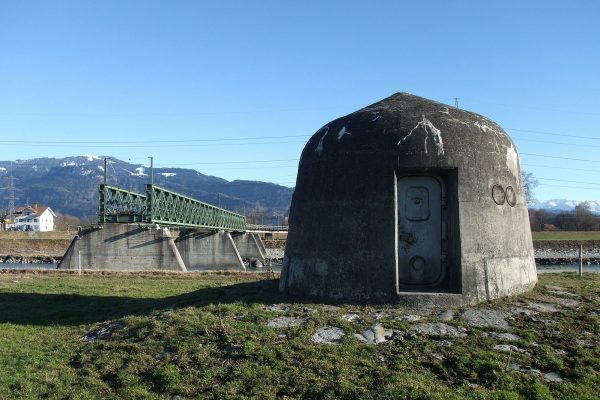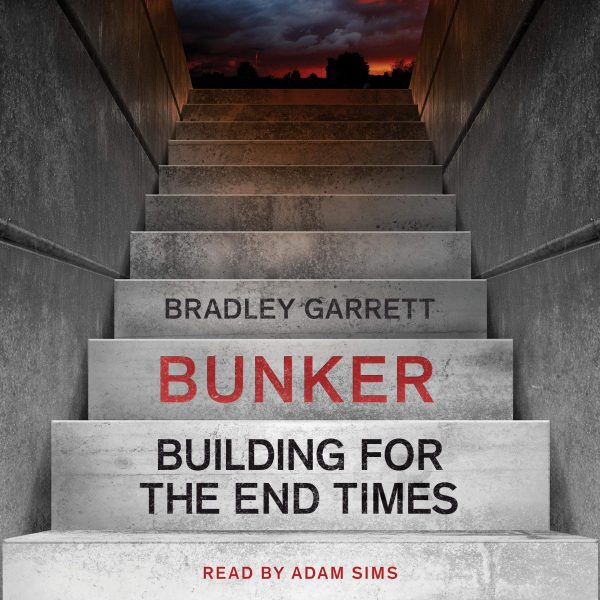There are lots of reasons to build underground. In Singapore, there are skyscrapers being constructed under the earth because the country has run out of space on the surface. In Toronto, Canada, there’s a network of tunnels called The Path that connects the whole downtown, so people never have to go outside in the winter. And then there is the curious architecture known as “the doomsday bunker.” According to author Bradley Garrett, for those of us who live in suburban and rural areas, it’s likely a neighbor has a bunker underneath their home that we’re totally unaware of. “Once you start looking,” says Garrett, “you see bunkers everywhere.”


Garrett’s new book is Bunker: Building for the End Times. He says that people have always built underground survival shelters to stay safe from plagues or floods. But in modern history, humans have really outdone ourselves. There are tens of thousands of government and military bunkers around the world, and potentially even more built by private citizens.
The first wave of bunkers was constructed during the Cold War when governments around the world were anxious about the prospect of nuclear war. Some governments decided to build underground shelter space on a massive scale. Switzerland famously passed a law making it mandatory for the government to provide bunkers for every Swiss citizen. But in the United States, the decision was made to build fewer bunkers, because of the astronomical cost. Estimates provided by the United States government projected it would cost the government’s GDP for an entire year to shelter the whole population.
Instead, a decision was made to build bunkers for American politicians and their aides, but not their families. In 1961, President John F. Kennedy made a famous speech warning Americans about the dangers of nuclear fallout, and advocating for more bunker space as a key defense against the Soviets. This warning triggered the first “doom boom” and a multimillion-dollar industry sprung up overnight of private contractors rushing to excavate people’s backyards and build nuclear fallout shelters. Today, Garrett says we are living through a second doom boom, with people of all stripes building underground emergency space all over the world.

In this discussion, Garrett explores the rapidly growing movement of ordinary citizens “prepping” for social and environmental collapse. From government-run facilities in the American Midwest, to eco-fortresses in Thailand, to luxury condos deep within the earth… Garrett shows us that bunkers are all around us.



Comments (2)
Share
Listening to Doom Boom and comments about fallout shelters brought back many memories:
At the beginning of the Cold War era my father – Joseph W. Klinsky – was a bacteriologist in the University of Iowa Preventative Medicine labs. At the beginning of the ’50’s his research involved tracking brucellosis in the waterways of Iowa and determining if there was potential carryover in to the dairy herds in the state (Yes – Iowa really did have dairy herds then), and that involved in taking water samples from farm ponds and milk samples from dairy barns. He had an excellent rapport with the land owners, and I often accompanied him on his rounds to collect samples.
When the Cold War blossomed and atmospheric testing became rampant, the U.S. needed to develop infrastructure and expertise to track Radioactive Fallout, and the nature of his interest changed from following Brucellosis trails to examining fallout, including, but not limited to Strontium 90 in milk and Radium 235 in water. it was a perfect cover, with the logistics already in place to monitor fallout and Dad’s expertise became Radiation Chemist.
His lab was moved out of the Preventative Medicine Labs and in to a non-descript house off campus that was gutted, then fitted out with shielding vaults (to isolate samples from background radiation), a wide variety of counters, a Gamma Ray spectrometer, and electronics that were the state of the art for the day.
When a nuclear “event” occurred, anywhere in the Northern Hemisphere, the radioactive material would get up in to the Jet Stream and circle the globe within a matter of hours. Hi lab, crude by today’s standards, was sophisticated enough that they provide the Department of Defense a remarkably accurate description of the make-up of the device within 36 hours. (!! and this was still the era of slide rules).
Around 1958 (?), the Federal Civil Defense Administration sponsored a fallout shelter symposium at the Iowa City High School auditorium that engaged a panel of “experts” in the field of constructing and provisioning fall out shelters. My father represented the scientific community.
The presentation went smoothly enough with each panel member presenting a synopsis of their expertise – until it got to questions from the floor and someone asked my father to describe the fallout shelter that we had at home. Dad was a much better Radiation Chemist than he was a liar, and after an uncomfortable silence he murmured something to the effect of “well … we don’t have one” , and of course he was then placed in a position where he had no option but to explain why.
He then explained that they had been picking up traces of Cobalt in their samplings of radioactive fallout, and that in case of war, if the nuclear devices contained significant amounts of cobalt “You will not be able to leave your fallout shelters in two weeks …. it will be closer to two centuries.” As the representative from the Civil Defense tries to get new questions from the audience to save the credibility of the event, the audience left the auditorium without a sound. Not surprisingly, he was never invited to be on another Civil Defense panel.
In Doom Boom Bradley Garret made reference to fall out shelters that were built and provisioned for 14 days. He is correct. That was the suggested time frame, but that was woefully inadequate for the purpose for which they were supposed to address.
The Cold War was rife with misinformation designed to relieve the sense of helplessness of the population. Kids in schools instructed to crawl under their desks, if you are driving and there is a blast, get out of the car and lay in the ditch. The only effective appliance that I ever saw that offered an accurate response was a sealed glass bulb that contained a match and a cigarette with instructions that read “In case of Nuclear War,
1.) break glass,
2.) light and smoke the cigarette,
3.) Bend over and kiss your ass goodbye”
In the spring of 1960 (61?) The Soviet Union and the U.S.A. signed the Test Ban treaty, which was hailed as a huge step toward peace. That was not the reason for that treaty.
The Labs had been reporting levels of background radioactivity from fallout that were considered to be lethal if exposure continued over time. Keep in mind, these were levels that had been established after the bombing of Hiroshima and Nagasaki and were levels of background radiation that were much higher than what would be acceptable today. The Test Ban Treaties were a necessity to avoid the general populations of the Hemisphere with showing signs of Radiation Sickness. We can only speculate if, or how much, those levels of radiation affected the rise in diseases such as cancers, Leukemia etc in the decades that followed.
The Treaties were signed in late Spring, and the labs were watching radiation levels very closely, because they continued to rise for several weeks that followed. A date was set – my recollection is that the date was mid July of that year – by which if the levels of background radiation did not begin to fall, the Dept. of Civil Defense would have to issue public warnings to the effect of “Do not let your kids play outside, do not drink fresh milk, keep your homes closed ……”. Clearly not a preferred action after the reassurances that they had been issuing. For weeks my father would return from the labs with the weight of the world on his shoulders. The levels of background radiation finally began to fall TEN DAYS before the directives would have had to have been issued. `
From its title, I was hoping this episode would be about the meteoric rise in popularity of MF Doom since his death and the media phenomenon that surrounded it.
It wasn’t that. At least it was about “end times” , which is always amusing.
Usually I love the show, but in my humble opinion it got worse (and worse, and worse) from there.
According to the author you interviewed, “For those of us who live in suburban and rural areas it’s not unlikely that one of your neighbors has a bunker underneath their house that you don’t know about.”
What an exaggeration. I guess it depends how you define “unlikely” and “neighbors”.
Later he admitted, “I’m supposed to be a social scientist, let me give you some numbers here.” But didn’t provide any.
He related some research from an unnamed Ph.D student that suited his book pitch, then exaggerated them, proceeded to extrapolate them into even more theoretical territory.
Were they peer-reviewed? Published? In what journal? Validated? By whom? What other data exist?
At it goes on…
How “lucrative” is the business of bunkers, really? Just one obvious question: How many units at “Survival Condo” were sold, for what profit?
In other words, how much of this supposed “Doom boom” is real?
I don’t doubt there has recently been a spike in armageddonists, nor that it’s a new phenomenon, but let’s not exaggerate, especially not for personal profit, and not at further expense of truth.
This episode is not why I listen to 99% Invisible, nor is it one I ever suggest it to a friend.